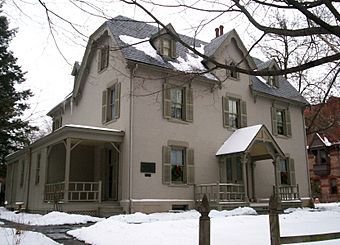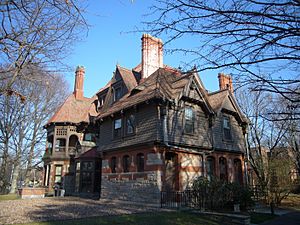Harriet Beecher Stowe House (Hartford, Connecticut) facts for kids
|
Stowe Center for Literary Activism
|
|
|
U.S. Historic district
Contributing property |
|
 |
|
| Location | Hartford, Connecticut |
|---|---|
| Built | 1871 |
| Architectural style | Gothic |
| Website | www.harrietbeecherstowecenter.org |
| Part of | Nook Farm and Woodland Street District (ID79002674) |
| NRHP reference No. | 70000710 |
Quick facts for kids Significant dates |
|
| Added to NRHP | October 6, 1970 |
| Designated NHL | February 27, 2013 |
| Designated CP | November 29, 1979 |
The Stowe Center for Literary Activism is a special place in Hartford, Connecticut. It's a history museum that was once the home of Harriet Beecher Stowe. She was a famous writer who wrote the important book Uncle Tom's Cabin in 1852.
Harriet Beecher Stowe lived in this house for the last 23 years of her life. It was her family's second home in Hartford. The house is a cottage-style building, about 5,000 square feet in size. It's right next to the Mark Twain House, another famous author's home. Today, the Stowe Center is open to everyone who wants to visit. It became a National Historic Landmark in 2013, which means it's a very important historical place in the United States.
Contents
What the Stowe House Looks Like
The Stowe House is a two-story building made of brick, painted gray. It has a unique and interesting roof design. The roof has different sections, including gables and dormer windows. These parts are decorated with fancy wooden trim.
Inside, the house has a classic layout. On the first floor, you'll find two living rooms, a dining room, a kitchen, and a pantry. The bedrooms are located upstairs on the second floor. This house was the first home built especially for Harriet Beecher Stowe and her family.
A Look at History
Harriet Beecher Stowe and her husband, Calvin Ellis Stowe, used to live in Massachusetts. Calvin was a teacher. When he decided to leave his job in 1863, Harriet started getting their first home in Hartford ready.
Building a house during the American Civil War was tough because costs kept changing. But Harriet loved being in charge of the work. She even wrote to her publisher about how excited she was about the garden. She named this first home "Oakholm." By May 1864, the house was almost ready.
However, by 1873, Oakholm became too expensive to keep up. So, the Stowes sold it and moved to the house on Forest Street, which is the museum today. This house was originally built by Franklin Chamberlin. He also sold the land next door to Mark Twain, where the Mark Twain House was built.
Harriet Beecher Stowe lived in the Forest Street house for the rest of her life, for 23 years. While living there, she continued to write. She also went on two speaking tours. She helped support the local Wadsworth Atheneum art museum and helped start the Hartford Art School. This school is now part of the University of Hartford.
Harriet Beecher Stowe passed away in her upstairs bedroom in 1896. Her children, her sister Isabella Beecher Hooker, and other family members were with her.
The Stowe Center for Literary Activism Today
The Stowe Center for Literary Activism works to keep Harriet Beecher Stowe's Hartford home and its historical items safe. It also encourages important discussions about her life and work. The center aims to inspire people to work for social justice and positive change.
After Harriet Beecher Stowe died, her house was sold outside the family. But in 1924, her grandniece, Katharine Seymour Day, bought it back. Katharine also bought the nearby Mark Twain House in 1929, saving it from being torn down.
Katharine Day left her Hartford properties to a foundation. This foundation is now known as the Stowe Center for Literary Activism. It was officially started in 1941. The organization carefully restored the house between 1965 and 1968. It opened as a historic house museum in 1968.
Today, you can take guided tours of the house. You'll see original furniture and items that belonged to the Stowe family. More than 25,000 people visit the center each year.
Besides the Stowe House, the Center also manages an old carriage house from 1873. This building now serves as the visitor's center. They also care for the Katharine Seymour Day House, built in 1884. The Stowe Center has a research library with letters and documents from the family. Its collections include about 6,000 objects and over 200,000 manuscripts, books, and photos. The site is part of the Connecticut Women's Heritage Trail.
The Stowe Prize
The Stowe Center for Literary Activism gives out a special award each year called the Stowe Prize. It's given to a U.S. author whose writing has helped people think about important social issues. This award honors Harriet Beecher Stowe's own work, like Uncle Tom's Cabin.
Some of the people who have received the Stowe Prize include:
- Nicholas Kristof and Sheryl WuDunn (2011), for their book Half the Sky: Turning Oppression into Opportunity for Women Worldwide.
- Michelle Alexander (2013), for The New Jim Crow: Mass Incarceration in the Age of Colorblindness.
- Ta-Nehisi Coates (2015), for his article "The Case for Reparations".
- Bryan Stevenson (2017), for Just Mercy: A Story of Justice and Redemption.
- Matthew Desmond (2018), for Evicted: Poverty and Profit in the American City.
- Albert Woodfox (2020), for Solitary.
- Clint Smith (2022), for How the Word Is Passed: A Reckoning with the History of Slavery Across America.
See also


